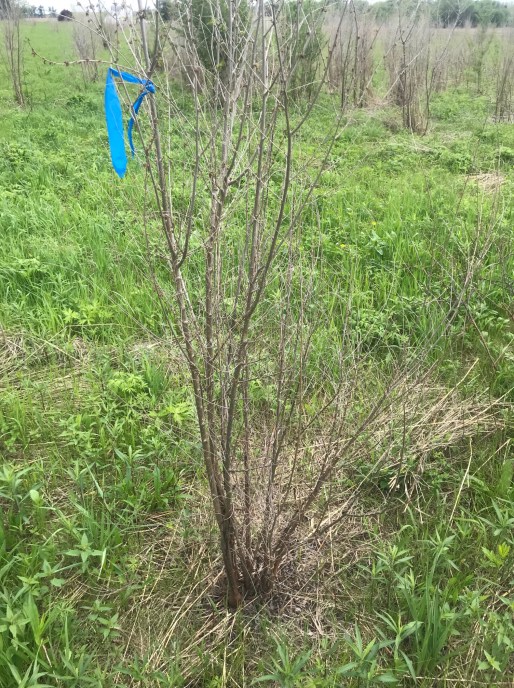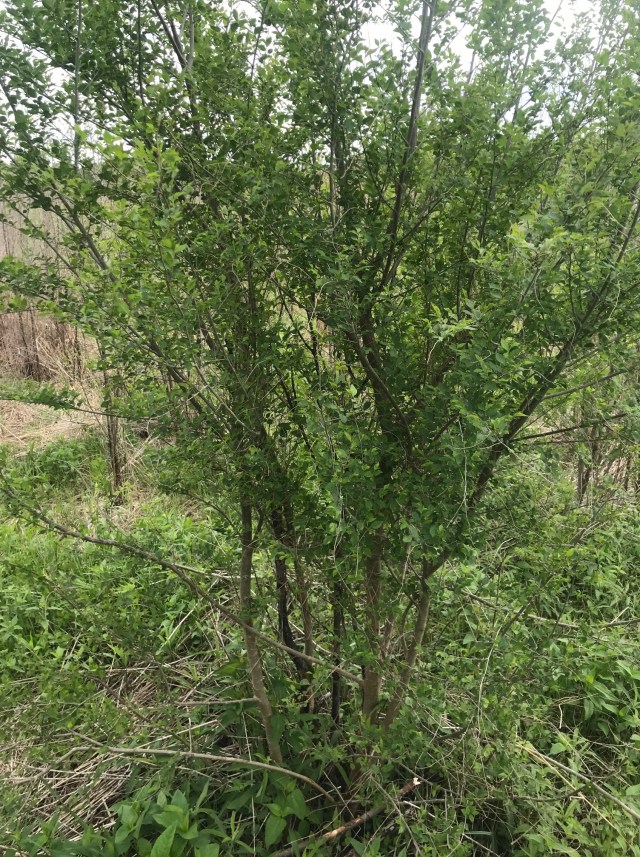20% garlon 4 in basal bark oil sprayed at the base of invasive Siberian elm, Ulmus pumila, kills these small elm trees growing in our prairie planting. Above is one dead elm. There is a small ring of dead, or at least wilted, herbaceous plants at the base.
Near this prairie planting, there are a few big Siberian elm trees that lofted seeds across acres. We keep top killing them with annual fire and they keep re-sprouting. Last year the crew applied a small amount of basal bark herbicide to thousands of these shrub sized trees and they appear to have all died.
Below is an untreated Siberian elm:



Have you observed how long it takes until forbs will again grow in the areas impacted by the spraying? I did basal bark work on buckthorn this winter using a paint roller. Forbs were only present on the edge of the buckthorn thicket. I noticed several forbs in among the treated buckthorn showed some impact from my late fall/winter application. I am now wondering if the herbicide application might stop forbs from establishing in the interior of the treated buckthorn thickets for at least a few years.
Bill K here. There is a wilting of vegetation within several inches to a foot of the basal bark treated stems. Whether these plants are dead or wilted remains to be seen. Kaleb Baker is just finishing his study of this specific question and hopes to publish a paper within the year.
I have been thinking about the result of my application of triclopyr to the basal bark of buckthorn growing in dense thickets this past winter. What strikes me most, after having recently visited the area, is nothing is growing in the thicket of dead buckthorn other than a sparse clump of sedges that was present before the treatment. In contrast, when I applied glyphosate to a frill, quality species became noticeable where the buckthorn had not gotten too dense. In areas where I had done frilling, that were heavily shaded by buckthorn, their was vigorous growth of Erechitites hieracifolia and other weedy species.
I am going to watch how the vegetation in the area I treated with triclopyr develops. However, I am concerned that I am not even seeing weeds growing. Using a brush cutter to cut woody species and apply glyphosate to the stump does not take much more time than basal bark application. It would be interesting to compare the vegetative response after basal bark application with triclopyr versus the response after cut stump treatment with glyphosate.
I followed the manufacturers recommendation when applying the triclopyr, but it appears to have been too much herbicide even at the lowest recommended concentration. I tried 20, 25, and 30 % active ingredient to one foot of stem length. All concentrations were highly effective, which makes me think one foot of stem length was too much. I want to try varying the amount of stem length using the lowest recommended active ingredient concentration of 20 % to see at what point the effectiveness of the herbicide starts decreasing. I am hoping a reduced amount of herbicide will still prove effective at controlling buckthorn but not harm adjacent vegetation.
In my previous comment, I had my concentrations wrong. I actually used 20, 25, and 30 percent product in crop oil. The product was 61.6 % triclopyr. The active ingredient concentrations then would be about 12, 15, and 18 percent. I only discovered my error after looking at my notes from when I did the application.
the death circle from triclopyr and crop oil is real, generally we use it only in bombed out bush honeysuckle thickets or lower quality woodlands if possible. I’ve never been happy with cut stump glyphosate success.
Try applying more glyphosate. For honeysuckle, I would put 41 % a.i. glyphosate on the cut until it was about ready to drip. I would then let the herbicide soak in and then apply the herbicide the same way a second time. For buckthorn you could probably get away with applying a lower concentrations (~30 % a.i.) in this manner just once.
Although I have not seen an impact to herbaceous vegetation the season following an application of glyphosate to frill or cut stump during late fall/winter, I have seen woody species impacted. I am kicking myself for killing one stem of a prairie crabapple that was about a foot from a buckthorn I treated. I have also seen an impact on untreated gray dogwood that were in a treated sumac clone. In addition to reducing the amount of herbicide I am using, preventing damage to nearby desirable woody species is the reason I am trying to use the minimum amount of herbicide needed for the treatment to be effective. It is a rather careful balancing act. If what you are controlling is in close proximity to a woody species you cannot risk killing then the safest course of action would be to use methods that don’t require herbicide like repeated defoliation or buckthorn baggies.
Today, I went to where that patch of prairie crabapple I mentioned previously is located. The one stem I thought I killed is alive. It just leafed out later than all the other stems and the leaves are mis-shaped. I now wonder if the herbicide application I did to a nearby buckthorn two and a half years ago is still causing this one crabapple stem to leaf out later and have mis-shaped leaves or if there is some disease or other cause of this abnormality.
Some untreated gray dogwood, buckthorn, and raspberries in the sumac clone I previously mentioned treating are either dead or showing impact. This tells me that I need to keep refining the concentration of herbicide I am using. However, I am not worried about killing any of these species like I am about killing the prairie crabapples.
One more thing … when doing cut stump application make sure the stumps are as low as possible. If the stumps are cut high above the ground then a higher concentration, or more herbicide, needs to be applied to get the same level of control.